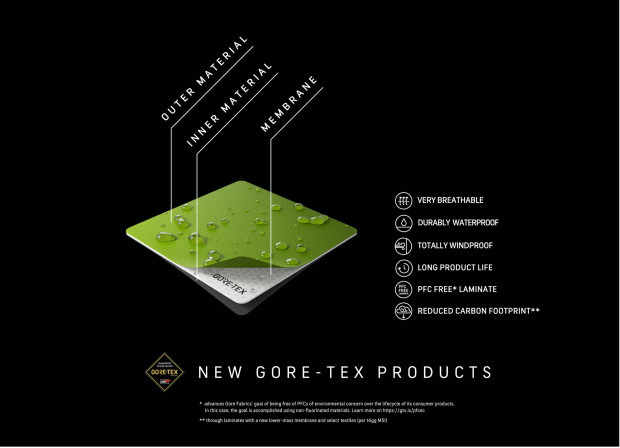Classic GORE-TEX is heavy, loud, and packed with forever chemicals. But, after five years of research and development, it’s had a complete makeover. GORE-TEX and Patagonia have replaced expanded harmful polytetrafluoroethylene (PTFE) chemicals with more environmentally responsible ePE (expanded polyethylene).
“It’s the same great waterproof protection,” says Linden Mallory, Alpine global product line director at Patagonia. “But when you look at it closely, it’s softer, more comfortable, and slightly lighter. And it’s quieter—less crinkly—because it has less mass.”
Mallory is describing the new GORE-TEX, which Patagonia helped bring to market. Patagonia was the first to release it, starting in Fall 2022 with its 2-layer Storm Shift series. And for fall 2023, it's adding the new material to its 3-layer collection: You'll find it in the Triolet Jacket and Pants, SuperFree Alpine Jacket, and SuperFree Alpine Suit (unisex). Other GORE partners are following suit.
Related: The Best Side-by-Side UTVs of 2023
“It was a long-term thing, like a dream idea,” Mallory says of bringing the new GORE-TEX to market. By partnering, Patagonia took about five years off production to get the new membrane into production.

Courtesy Image
Testing GORE-TEX Products With ePE Membrane
This past winter, I met with Patagonia, donned the SuperFree Alpine Suit, and climbed the longest-continuous ice route in Hyalite Canyon just outside Bozeman, CO. Our team moved together, being sure to give ample space when swinging axes and puncturing ice with razor-sharp crampons. We dashed up the steep, strenuous, lengthy approach, then climbed the vertical route. Despite pouring my heart and soul into the approach and climb, my Alpine Suit remained dry.
What makes Patagonia's Alpine Suit stand out was—despite being lighter than traditional GORE-TEX—it performed just as well as the previous generation, which has been on the market since 1976. Despite heavy perspiration and wet, cold, spindrift conditions, the suit never became damp or clammy. Moisture was pulled out and, against the elements, the shell acted like a shield.

Courtesy Image
Difference Between PTFE and ePE Membranes
The fact is, consumers aren't supposed to notice a difference. That's the point. But what’s under the hood is entirely different. Traditional GORE-TEX is a synthetic material made of polytetrafluoroethylene or ePTFE (think Teflon).
These are environmentally impactful in production and made of forever chemicals, meaning they don't break down in landfills. Sure, it’s excellent at what it does—keeping you dry in extreme conditions—but it’s nasty from an environmental standpoint.
ePE is a more environmentally responsible solution. It’s still petrol-based, but the material is thinner, lighter, easier to break down, and PFC-free. Performance-wise, they're one and the same.
To be clear, the partnership with Patagonia and GORE is non-exclusive. Patagonia was just the first to come to market; GORE works with more than 100 partners in the outdoor space, so expect many of these to follow suit (e.g. includes Adidas, Arc’teryx, Lowa, Mammut, and The North Face).
“Fall 24 will be everybody—all GORE licensees,” says Dan Cauthorn, strategic account manager for GORE.

Courtesy Image
How to Care for ePE Membrane Outerwear
One thing to note is that ePE requires better care than previous GORE-TEX.
“From a care perspective, that’s the biggest thing,” continues Mallory. “Wash your jacket, regardless of whether you’re wearing a GORE layer with fluorinated or nonfluorinated chemistry as with the new line.”
Mallory says the ePE shells should be washed more often than the previous generation, and he says it doesn’t matter if you’re using powder or liquid detergent. “Everyone’s walking around with these jackets that haven’t been washed in 15 years, complaining they don’t work. You gotta do your laundry, man.”
Price-wise, there's a slight difference, and the new material is more expensive. “But this is less in response to in the membrane specifically and more about supply chain inflation and that’s across the board,” Mallory says.
“This is a huge transformation,” Cauthorn says. “The outdoor industry has been moving away from fluorinated chemicals for decades.”
It's up to consumers now to be eco-conscious about the gear they invest in.
from Men's Journal https://ift.tt/t4VGaBr
via IFTTT
